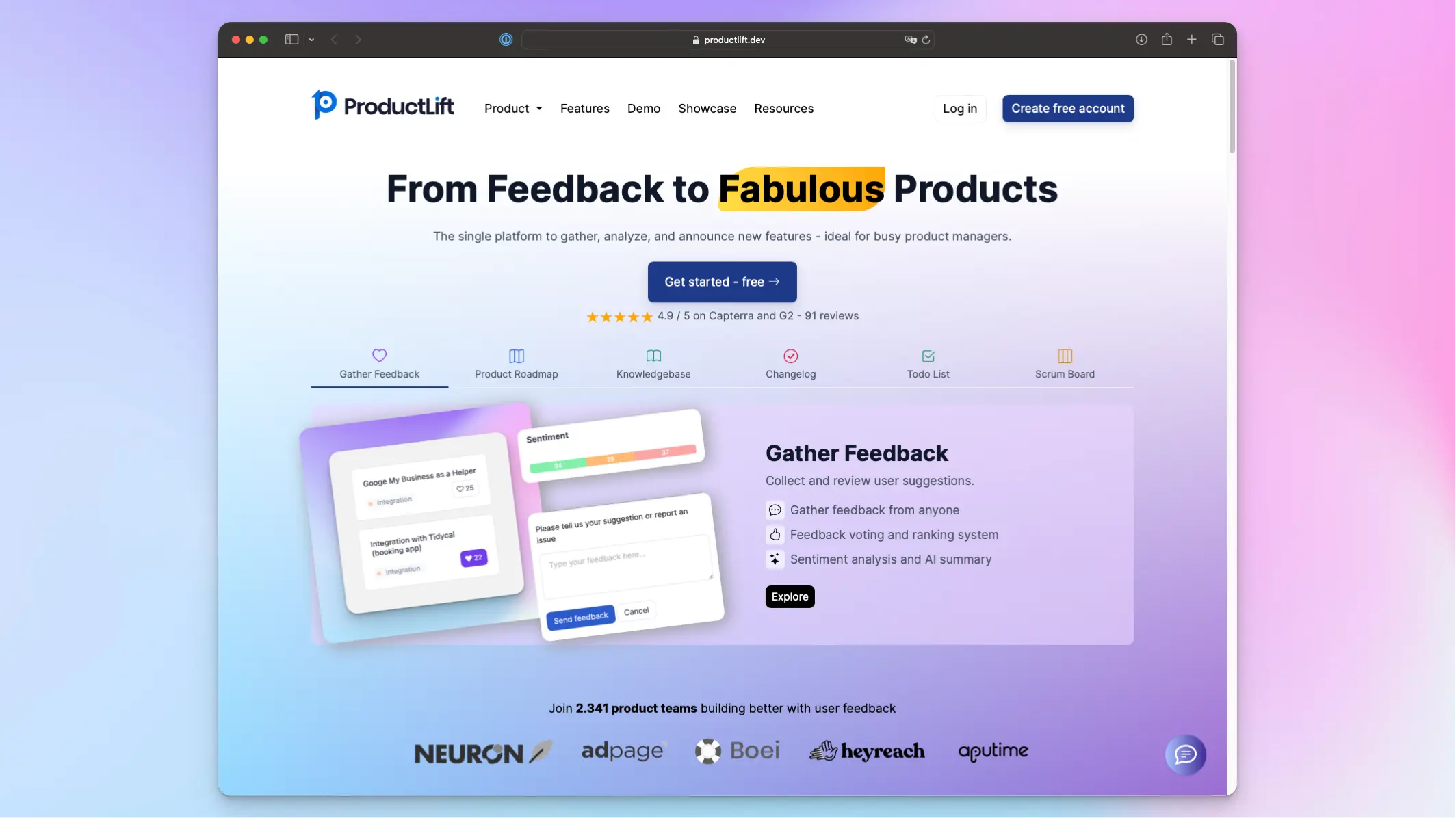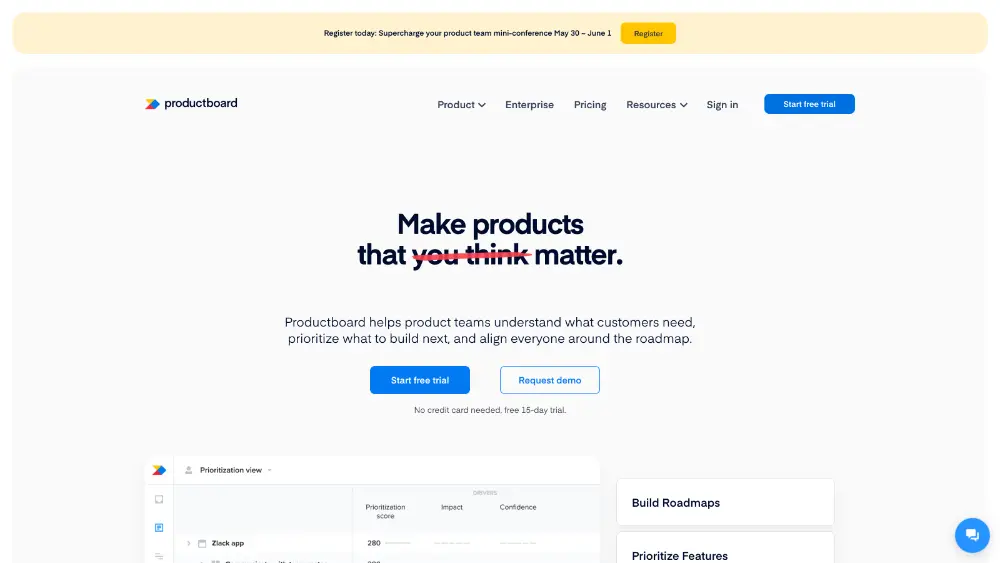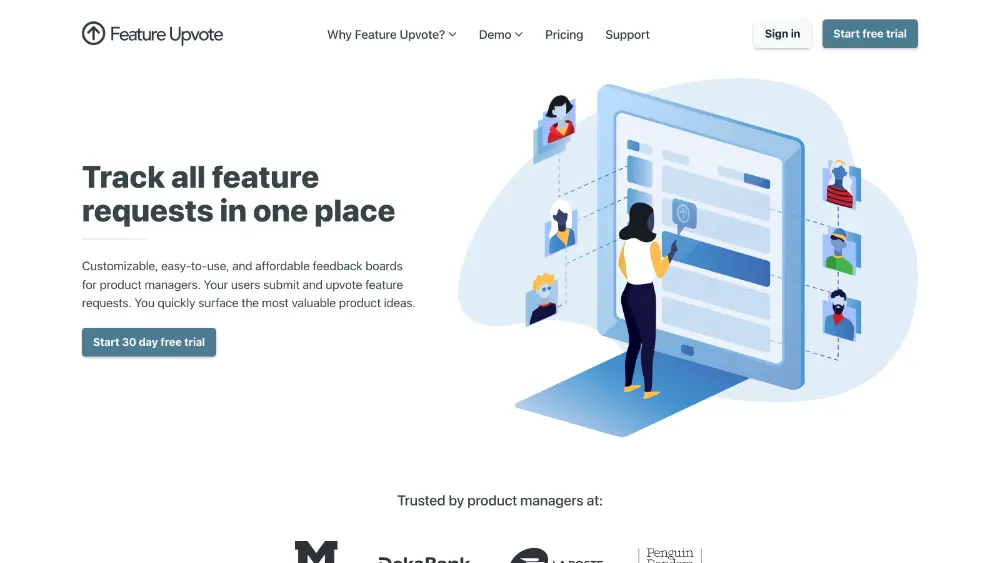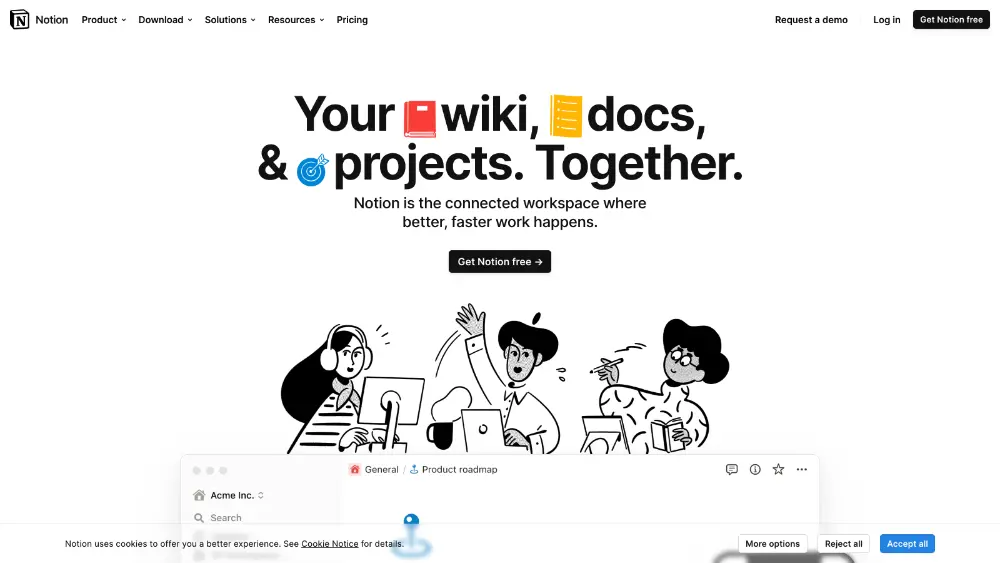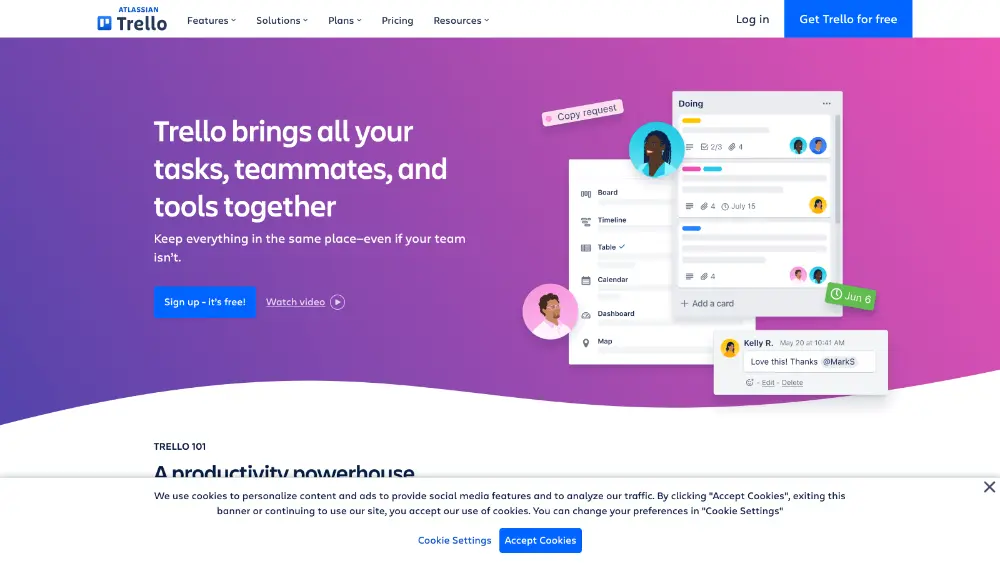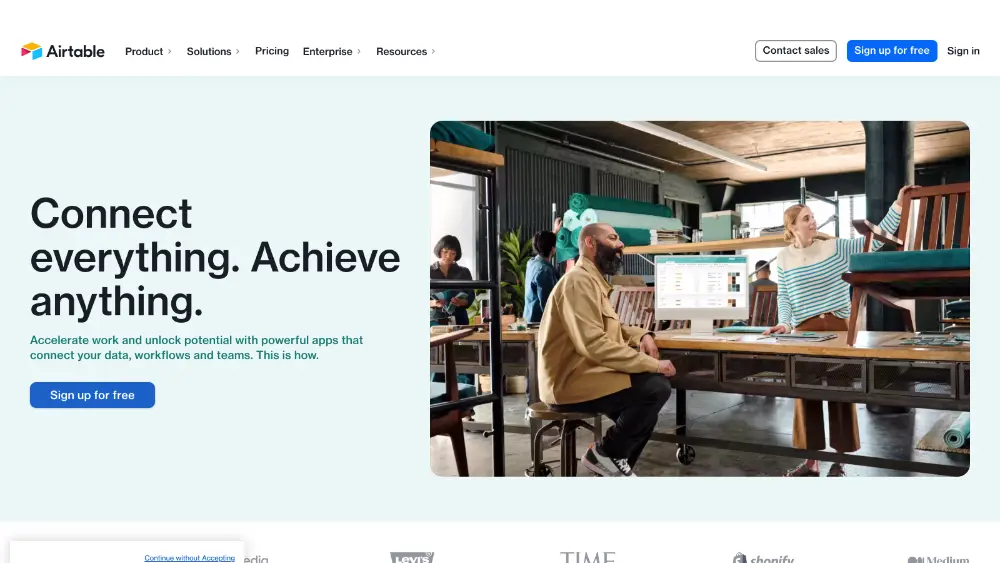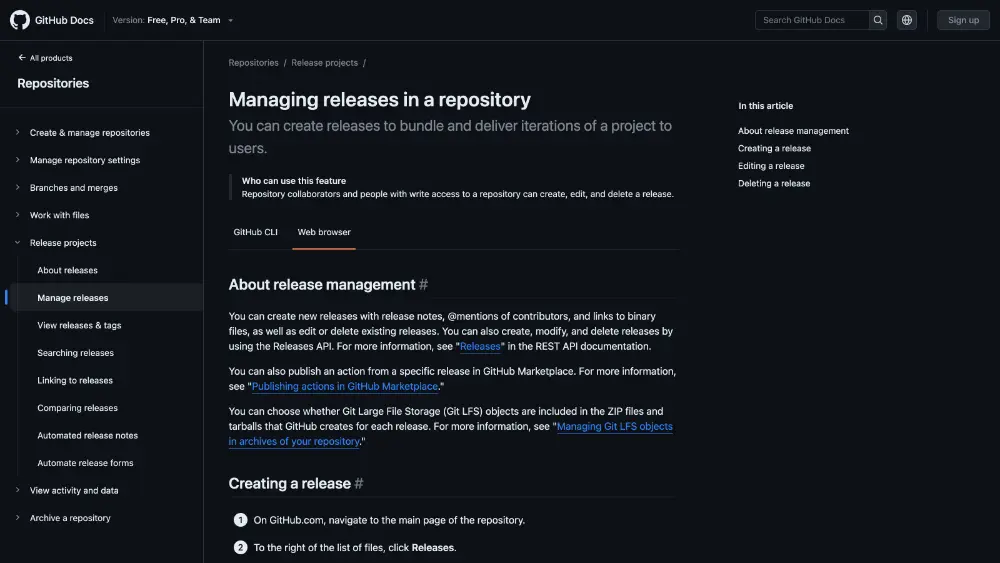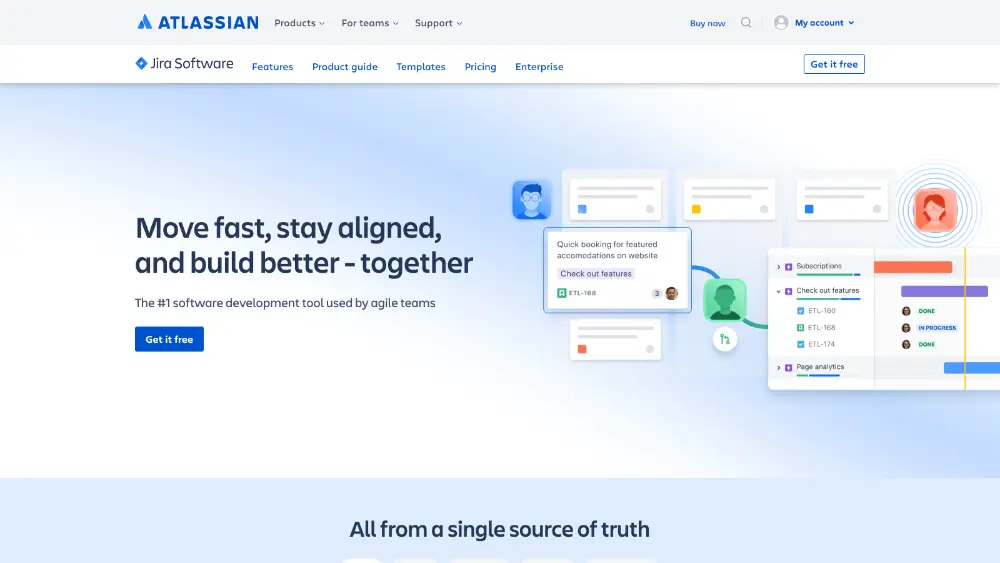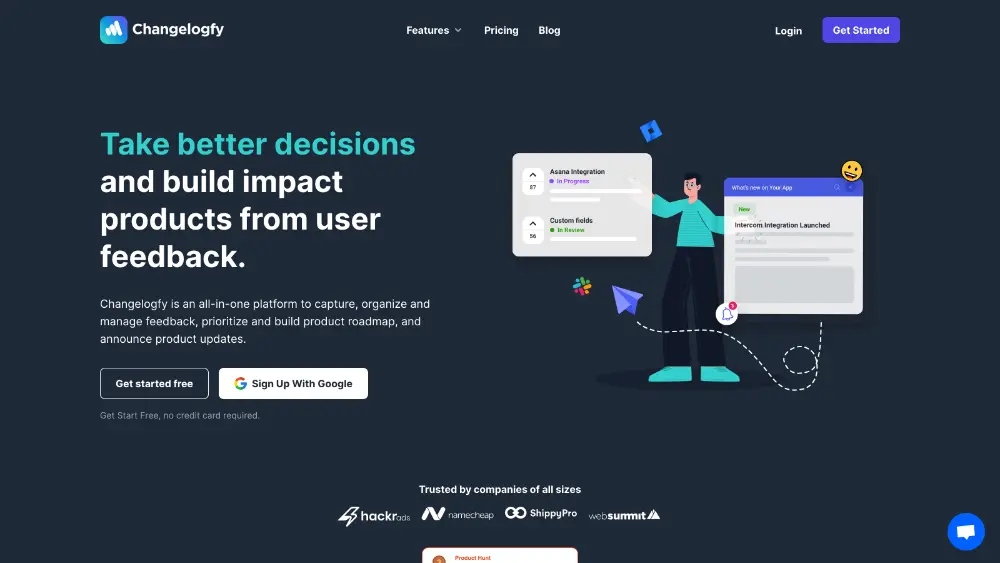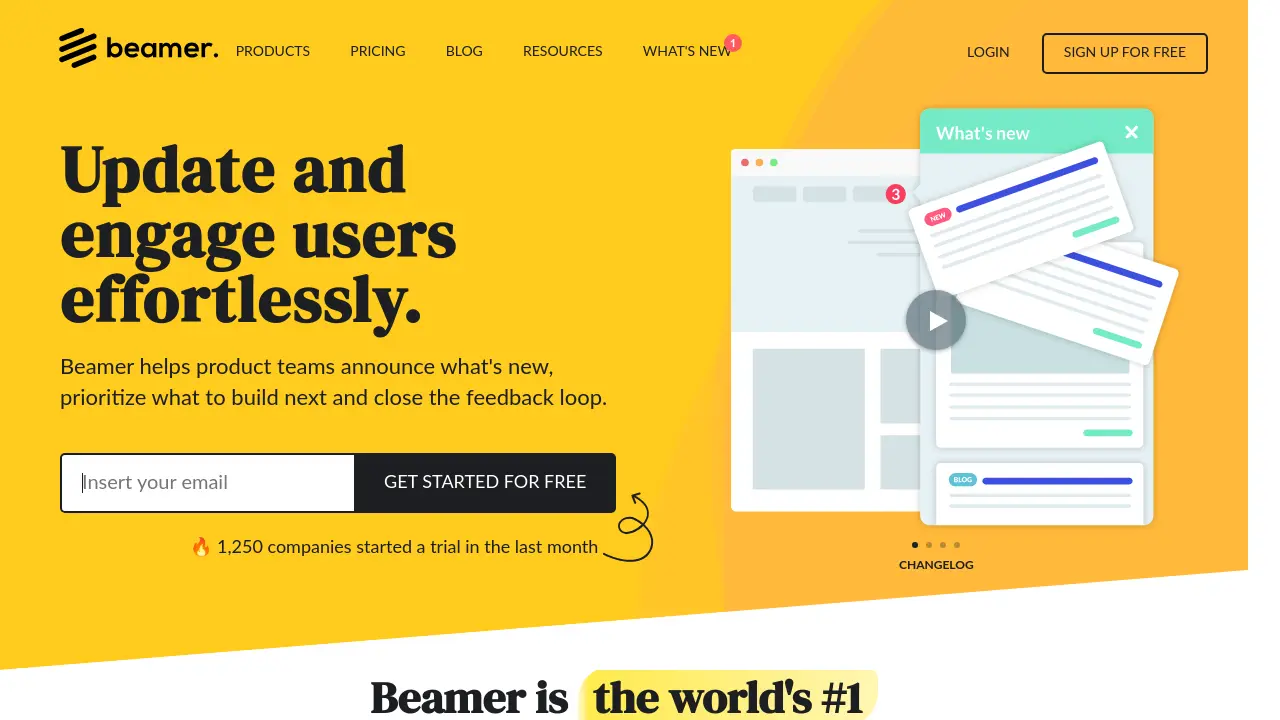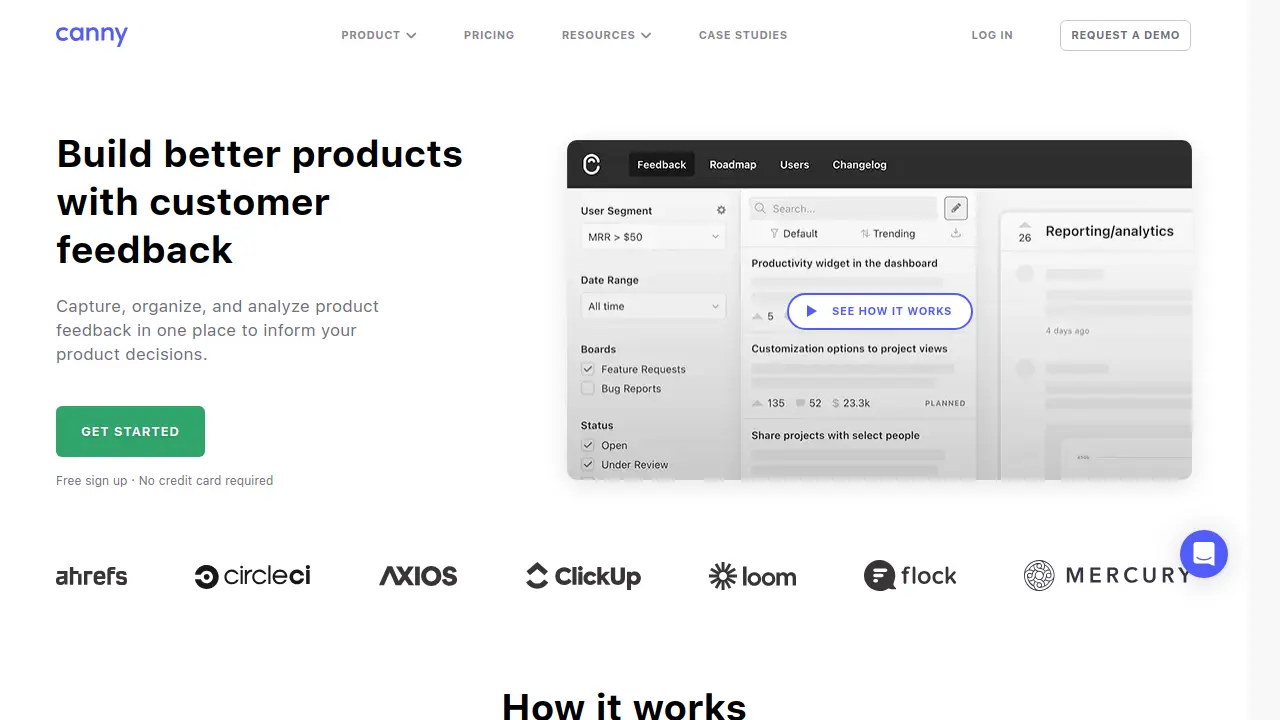The Ultimate Roundup: Top 11 Changelog Tools for SaaS Success

Ruben Buijs
Updated on Nov 19, 2025
Looking to improve your SaaS company's communication? I've listed the top 11 changelog tools that make tracking and announcing updates a breeze. We will look at user-friendly interfaces, automation, and customization options.
If you can't wait, here are the top 11 discussed in this article:
-
ProductLift
-
ProductBoard
-
Feature Upvote
-
Notion
-
Trello
-
Airtable
-
GitHub Releases
-
Jira
-
Changelogfy
-
Beamer
-
Canny
Best Changelog Tools for SaaS
1. ProductLift
Overview
ProductLift is an all-in-one tool designed for SaaS product managers, project managers, and marketing strategists who want to streamline their product development process. With ProductLift, you can keep your team and users up-to-date with product updates - a.k.a. the changelog tool. Next to this, you can also gather feature requests, prioritize features, and create roadmaps with ProductLift.
Features and benefits
With ProductLift's changelog tool feature, you can keep your team and users informed about the latest product updates, bug fixes, and feature releases. By communicating these updates regularly, you can increase user engagement and satisfaction. ProductLift provides a product changelog widget and a public changelog page on a custom domain. It is very easy to close the feedback loop and announce product updates with ProductLift because your feedback, roadmap, and changelog is on one location.
Pricing
ProductLift has pricing plans tailored to fit the needs of your SaaS app. Pricing starts at $22 a month. Pay annually and you'll get a discount equivalent to two months.
Pros and cons
Pro's
-
Easy to use: ProductLift is a very user-friendly platform that makes it easy to create and manage changelogs.
-
Automation: Items on your roadmap can be easily moved to your changelog tool without the need to rewrite them.
-
Extreme customization: ProductLift allows teams to customize their changelogs and board extensively, making it easy to tailor them to their needs and requirements.
Con's
- No versioning: ProductLift does not support versioning, making it difficult to track changes over time. You can, however, enter the version number in the title.
2. ProductBoard
Overview
Productboard is a popular product management system and a comprehensive solution that enables product teams to manage and prioritize their roadmap, collect and organize user feedback, and keep everyone in the organization aligned around the product vision.
Features and benefits
Productboard is a product management platform that offers features for creating and managing changelogs for software development teams. Its key features include an intuitive user interface, collaboration tools, and a customizable changelog. The platform enables users to create changelogs quickly and easily, with the ability to assign changes to specific team members and track their progress. It also allows users to collaborate on changelogs with stakeholders and integrate them with external tools. Additionally, Productboard provides analytics tools that enable teams to track changes' impact and identify improvement areas.
Pricing
Productboard offers different pricing plans based on the needs of your organization. The Starter plan is free, while the Team plan starts at $20 per user per month when billed annually. The Growth plan starts at $49 per user per month when billed annually. The Enterprise plan offers custom pricing. Productboard provides a 15-day free trial for the Team and Growth plans.
Pros and cons
Pros:
-
Intuitive interface: Productboard has a user-friendly and intuitive interface that simplifies creating and managing changelogs, making it easy for teams to get started and quickly adapt to the platform.
-
Collaboration tools: The platform offers robust collaboration tools that enable teams to work together on changelogs, share them with stakeholders, and get user feedback, leading to more effective and transparent communication.
-
Customizable changelogs: Productboard allows teams to customize their changelogs, making it easy to tailor them to their specific needs and requirements.
Cons:
-
Pricing: Productboard can be expensive for small teams or startups, with pricing plans starting at $49 per user per month.
-
Steep learning curve: While the interface is intuitive, some users may find the platform to have a steep learning curve due to its numerous features and customization options.
-
Limited customization on lower-tier plans: Some more advanced features are only available on higher-tier plans, which may be a drawback for smaller organizations.
3. Feature Upvote
Overview
Feature Upvote is a customer feedback and feature request tool that helps product teams prioritize and manage customer feedback. It allows customers to submit feature requests and vote on existing requests, giving product teams a better understanding of what their customers want. Feature Upvote also provides product teams with powerful analytics and reporting tools to help them make informed decisions about their product roadmap.
Features and benefits
Feature Upvote is primarily a tool for managing feature requests and user feedback rather than a dedicated changelog tool. However, it can be a useful tool for SaaS companies looking to keep their users in the loop about feature developments and updates. With an easy-to-use interface for submitting, voting, and tracking feature requests, teams can gain valuable insights into user needs and preferences and prioritize development accordingly. Customizable settings for voting restrictions, categories, and tags help to organize and streamline the feedback process. At the same time, integration with other tools, such as Slack and Zapier can ensure efficient communication and workflow.
Pricing
Feature Upvote offers a range of pricing plans to suit different needs. The Basic plan is free and allows users to collect feedback and prioritize features. The Pro plan starts at $99/month and includes additional features such as custom branding, advanced analytics, and user segmentation. The Enterprise plan is tailored to the needs of larger organizations and includes additional features such as custom integrations, dedicated support, and custom feature requests.
Pros and cons
Pros:
-
Easy to read: Feature Upvote's changelog tool is designed to be easy to read and understand. It clearly outlines the changes made in each release, making it easy for users to identify what has been added or changed quickly.
-
Comprehensive: Feature Upvote's changelog tool includes detailed descriptions of each change, making it easy to understand the impact of each update.
-
Visually appealing: Feature Upvote's changelog tool is visually appealing, making it easy to scan and identify changes quickly.
Cons:
-
Not customizable: Feature Upvote's changelog tool is not customizable, so users may be unable to tailor the format to their specific needs.
-
Limited information: Feature Upvote's changelog tool does not provide detailed information about the changes made in each release, making it difficult to understand the full impact of each update.
-
Not searchable: Feature Upvote's changelog tool is not searchable, making it difficult to find specific changes quickly.
4. Notion
Overview
Notion is a productivity and collaboration platform that combines the features of a note-taking app, task manager, and wiki. It allows users to create and organize notes, tasks, wikis, and databases in one place. It can also be used as a product changelog tool. Notion also offers a range of features, such as collaboration, task management, and document sharing. It is available on web, desktop, and mobile platforms.
Features and benefits
Notion is an all-in-one workspace tool that is commonly used for creating a changelog. It offers a collaborative workspace, which allows multiple team members to work together in real time, making it easy to create and maintain a comprehensive changelog. Notion also provides customizable templates for creating a changelog, which helps streamline the process and maintain consistency. With Notion, users can create rich content options such as text, images, and videos, making presenting the changes clearly and understandably easier. Additionally, Notion keeps track of all changes made to a page, enabling version control and providing integration with other tools such as Trello, Slack, and Google Drive. This feature allows for a more streamlined workflow, making it easy to keep the entire team informed and up-to-date. Notion also offers a mobile app, which allows users to access their changelog from anywhere, making it easier to stay on top of updates.
Pricing
Notion pricing is based on the number of users and the features needed. The free basic plan includes limited workspaces, blocks, and basic features. The Personal plan is $4/month and includes unlimited workspaces, blocks, and advanced features. The Team plan is $8/user/month and includes unlimited workspaces, blocks, advanced features, and team collaboration tools. The Enterprise plan is customized and includes unlimited workspaces, blocks, and advanced features, as well as team collaboration tools and custom integrations.
Pros and cons
Pros:
-
Easy to use: Notion is a very user-friendly platform that makes it easy to create and manage your product change log.
-
Flexible: Notion allows you to customize your changelog to fit your specific needs.
-
Collaboration: Notion makes collaborating with others on your changelog easy, allowing for quick and efficient changes.
Cons:
-
Limited features: Notion offers fewer features (like automated versioning and informing users) than some other changelog platforms.
-
Cost: Notion can be expensive for larger teams or organizations.
-
Limited integrations: Notion offers fewer integrations than some other changelog platforms.
5. Trello
Overview
Trello is a web-based project management and collaboration tool. It is designed to help teams organize and manage tasks, projects, and workflows. Trello uses a Kanban-style board system, which allows users to create boards, lists, and cards to track tasks and progress. It also offers features such as task assignments, due dates, labels, and comments.
Features and benefits
Trello is a project management tool that can also be used to create a changelog. With features such as customizable boards, lists, and cards, users can easily track and manage changes to their SaaS product. Benefits of using Trello for changelog creation include collaborating with team members, organizing and prioritizing tasks, and keeping track of updates and changes in a clear and organized way. Users can also integrate Trello with tools like Slack and Jira to streamline communication and workflow.
Pricing
Trello offers a free plan and three paid plans: Business Class, Enterprise, and Trello Gold. The free plan includes basic features like boards, lists, and cards. Business Class includes additional features such as unlimited Power-Ups, priority support, and administrative controls. Enterprise includes all of the features of Business Class, plus additional features such as unlimited members, unlimited boards, and advanced security. Trello Gold is a premium plan that includes all of the features of Business Class and Enterprise, plus additional features such as custom backgrounds, stickers, and emoji reactions. The pricing for Business Class is $9.99 per user per month, the pricing for Enterprise is $20.83 per user per month, and Trello Gold is $5 per user per month.
Pros and cons
Pros:
-
Easy to use: Trello is a very user-friendly platform that makes creating and managing tasks easy.
-
Flexible: Trello allows users to customize their boards and tasks to fit their needs.
-
Collaboration: Trello makes it easy to collaborate with others on projects, allowing users to assign tasks, comment, and share files.
Cons:
-
Limited features: Trello offers fewer features than other changelog management tools.
-
Limited integrations: Trello has fewer integrations than other changelog apps.
-
Limited customization: Trello offers less customization than other changelog tools.
6. Airtable
Overview
Airtable is a cloud-based platform that combines the features of a database, spreadsheet, and collaboration software. It enables users to store, organize, and visualize data flexibly, user-friendly way. Teams of all sizes use Airtable to manage projects, track data, and collaborate on tasks.
Features and benefits
Airtable can be used to create and manage a changelog. With its customizable table views, users can easily track and manage changes to their SaaS product in a clear and organized way. The tool's flexible architecture allows for easy integration with other tools and workflows, making it a versatile option for SaaS companies. Benefits of using Airtable for changelog creation include collaboration and communication between team members, the ability to create customized views and filters, and the option to automate tasks and workflows with integrations like Zapier.
Pricing
Airtable offers four pricing plans: Free, Plus, Pro, and Enterprise. The Free plan includes unlimited bases, records, and collaborators. The Plus plan costs $10/month and includes additional features such as file attachments, automation, and custom branding. The Pro plan costs $20/month and includes additional features such as advanced automation, custom views, and priority support. The Enterprise plan is tailored to the needs of larger organizations and is priced on a case-by-case basis.
Pros and cons
Pros:
-
Easy to use: Airtable is designed to be user-friendly and intuitive, making it easy to create and manage changelogs.
-
Flexible: Airtable allows users to customize their changelogs to fit their needs.
-
Collaborative: Airtable makes it easy to collaborate with others on changelogs, allowing multiple users to make changes and view the changelog in real time.
Cons:
-
Limited features: Airtable offers fewer features than some other SaaS changelog tools.
-
Cost: Airtable is a paid service, which can be expensive for some users.
-
Limited integration: Airtable does not offer many integrations as other changelog SaaS tools.
7. GitHub Releases
Overview
GitHub Releases is a feature of GitHub that allows developers to package and distribute software releases. It provides a way to store and share software packages, as well as a way to track changes and manage versions. GitHub Releases also allows developers to attach release notes, binary files, and other assets to a release.
Features and benefits
GitHub Releases allows users to create and manage a changelog for their software products. With GitHub Releases, users can easily track and communicate updates and changes to their SaaS product in a clear and organized way. The tool's version control capabilities allow users to keep track of changes over time and maintain a complete history of their product updates. The benefits of using GitHub Releases to create a changelog include collaboration and communication between team members, the ability to tag and categorize releases, and the option to include additional documentation or release notes. GitHub Releases also integrates with other tools and workflows, such as automated deployment pipelines, to streamline the development process.
Pricing
GitHub Releases pricing is based on the number of repositories and users that are associated with the account. For public repositories, there is no cost associated with creating a release. For private repositories, the cost is based on the number of users and repositories associated with the account. For organizations, the cost is based on the number of users and repositories associated with the account. Additional costs are associated with using GitHub Actions, GitHub Packages, and GitHub Insights.
Pros and cons
Pros:
-
Easy to use: GitHub Releases is a simple and straightforward way to create and manage changelogs.
-
Automation: GitHub Releases can automatically generate changelogs when new commits are pushed to the repository.
-
Visibility: GitHub Releases are visible to all repository users, making it easy to keep track of changes.
Cons:
-
Limited customization: GitHub Releases offers few customization options, making it difficult to tailor the changelog to specific needs.
-
No versioning: GitHub Releases does not support versioning, making it difficult to track changes over time.
-
No integration: GitHub Releases does not integrate with other services, making sharing changelogs with other platforms difficult.
Jira
Overview
Jira is a project management and issue-tracking software developed by Atlassian. It is used for bug tracking, issue tracking, and project management. Jira provides a platform for users to plan, track, and release software projects. It also allows users to prioritize and assign tasks, track progress, and collaborate with other team members.
Features and benefits
Jira can be used to create and manage a changelog. With its customizable issue-tracking system, users can easily track and manage changes to their SaaS product in a clear and organized way. The tool's agile methodology allows for efficient collaboration and communication between team members, while customizable workflows and statuses help to streamline the development process. Benefits of using Jira for changelog creation include the ability to customize issue types, fields, and workflows, as well as the option to integrate with other tools and workflows such as GitHub and Bitbucket. Jira also offers reporting and analytics capabilities to help users gain insights into their development process and track progress over time.
Pricing
Jira offers a variety of pricing plans to suit different needs. The pricing plans range from a free plan for small teams to an enterprise plan for large organizations. The free plan includes basic features such as issue tracking, project management, and basic reporting. The Standard plan includes additional features such as advanced reporting, time tracking, and more. The Premium plan includes additional features such as advanced security, custom workflows, and more. The Enterprise plan includes all features and is tailored to the needs of large organizations.
Pros and cons
Pros:
-
Easy to use: Jira is designed to be user-friendly and intuitive, making it easy to learn and use.
-
Flexible: Jira is highly customizable, allowing users to tailor the system to their needs.
-
Automation: Jira can automate many tedious tasks associated with changelog creation, such as tracking changes and generating reports.
Cons:
-
Cost: Jira can be expensive, especially for larger organizations.
-
Complexity: Jira can be complex to set up and configure and may require additional user training.
-
Limited features: Jira does not offer some of the more advanced features found in other changelog creation tools.
Changelogfy
Overview
Changelogfy is a cloud-based platform that helps companies track, manage, and communicate product changes. It provides a centralized place to store and share product updates, feature releases, bug fixes, and other changes. It also allows users to create custom changelogs, track customer feedback, and measure the impact of changes.
Features and benefits
Changelogfy enables SaaS companies to communicate software updates and changes to their users. With Changelogfy, users can easily create, publish, and manage their changelog in a clear and organized way. The tool offers features such as customizable templates, release notes, and email notifications to inform users about new features and updates. Changelogfy also offers analytics capabilities to help users understand how their users are interacting with their product and prioritize development accordingly. With integration options for tools like Slack and GitHub, Changelogfy can help streamline communication and workflow.
Pricing
Changelogfy offers a range of pricing plans to suit different needs. The Basic plan is free and includes up to 5 users, unlimited changelogs, and basic support. The Pro plan is $19/month and includes up to 10 users, unlimited changelogs, and priority support. The Enterprise plan is $99/month and includes up to 50 users, unlimited changelogs, and priority support. All plans include unlimited changelogs, and all plans include access to the Changelogfy API.
Pros and cons
Pros:
-
Easy to use: Changelogfy is designed to be easy to use, with a simple and intuitive interface that makes it easy to create and manage changelogs.
-
Automated notifications: Changelogfy can be set up to automatically send notifications to users when changes are made, ensuring that everyone is kept up to date.
-
Customizable: Changelogfy allows users to customize their changelogs to fit their specific needs, including the ability to add custom fields and tags.
Cons:
-
Limited features: Changelogfy offers fewer features than some of its competitors, such as tracking changes over time.
-
Limited integrations: Changelogfy offers fewer integrations than some of its competitors, such as the ability to integrate with bug tracking systems.
-
Limited support: Changelogfy offers less support than some of its competitors, such as the ability to contact customer service for help.
Beamer
Overview
Beamer is a product update and notification tool designed for SaaS companies to improve user engagement and retention. With Beamer, users can easily create and publish updates, announcements, and release notes directly on their website or web app, as well as through email and in-app notifications. The tool offers customizable templates, segmentation options, and analytics to help users target the right users with the right messages and measure engagement and feedback. Beamer also integrates with popular tools such as Slack, Trello, and Zapier to streamline communication and workflow.
Features and benefits
Beamer can be used to create and manage a changelog for SaaS companies. With its customizable update feed, users can easily track and manage product updates and changes, as well as communicate them to their users through email and in-app notifications. The tool offers features such as customizable templates, segmentation options, and analytics to help users target the right users with the right messages and measure engagement and feedback. Beamer also integrates with popular tools like Slack, Trello, and Zapier to streamline communication and workflow. Benefits of using Beamer for changelog creation include improved user engagement, the ability to target the right users with relevant updates, and increased transparency and communication with users.
Pricing
Beamer offers a range of pricing plans to fit the needs of different types and sizes of businesses. The plans start with a free option that includes basic features such as unlimited updates, analytics, and integrations. The paid plans start at $49 monthly and offer additional features such as customization options, advanced analytics, and team collaboration tools. The pricing is based on the number of active users and updates, with additional users and updates available for an additional cost. Additionally, Beamer offers a 14-day free trial for users to test the features before committing to a paid plan. Overall, the pricing of Beamer is flexible and scalable, making it accessible to businesses of all sizes.
Pros and cons
Pros:
-
Customizable update feed: Beamer provides a customizable update feed that allows users to organize and present changelog information to suit their business needs and branding.
-
Multiple notification channels: Beamer offers multiple notification channels, including email, in-app notifications, and social media integrations, enabling businesses to reach out to their users through their preferred channel.
-
Analytics and feedback features: Beamer provides analytics and feedback features that allow users to measure user engagement with changelog updates and gather feedback for future development.
Cons:
-
Limited customization in free plan: The free plan of Beamer has limited customization options, which can limit a business's ability to brand and tailor their changelog updates to their audience.
-
Lack of automation: Beamer requires users to manually input changelog information, which can be time-consuming and may lead to errors or inconsistencies.
-
Relatively high pricing: While the pricing of Beamer is flexible and scalable, it may be relatively high compared to other changelog tools, especially for smaller businesses or startups with limited resources.
Canny
Overview
Canny is a product feedback management tool that enables SaaS companies to collect, organize, and prioritize customer feedback and feature requests. The tool allows users to create customizable feedback boards where customers can submit and vote on ideas and comment and discuss proposed features. Canny also provides analytics and reporting features to help users understand customer feedback and prioritize development accordingly. Additionally, the tool integrates with other tools and workflows such as Slack and Trello to streamline communication and workflow.
Features and benefits
Canny can also be used to create and manage a changelog for SaaS companies. With its customizable feedback boards, users can easily track and manage product feedback and feature requests and communicate updates and changes to their users. The tool offers features such as customizable templates, voting and commenting capabilities, and email notifications to inform users about new features and updates. Canny.io also integrates with tools like Slack and Zapier to streamline communication and workflow. Benefits of using Canny.io for changelog creation include improved user engagement, the ability to prioritize development based on user feedback, and increased transparency and communication with users.
Pricing
Canny is a subscription-based software platform offering pricing plans based on the users and features needed. The basic plan starts at $99/month for up to 10 users and includes basic features such as task management, project tracking, and reporting. The Pro plan starts at $199/month for up to 25 users and includes additional features such as custom fields, automation, and integrations. The Enterprise plan starts at $499/month for up to 100 users and includes additional features such as custom branding, advanced analytics, and priority support.
Pros and cons
Pros:
-
Easy to use: Canny is designed to be user-friendly and intuitive, making it easy for anyone to create a changelog.
-
Automated: Canny automatically tracks changes and updates, so you don't have to enter them manually.
-
Customizable: Canny allows you to customize the look and feel of your changelog, so you can make it look exactly how you want.
Cons:
-
Limited features: Canny only offers a few features as other changelog tools.
-
Cost: Canny is a paid service, so there may be better options for those on a budget.
-
Limited support: Canny offers less support than other changelog tools.
What to look for in a changelog tool
When it comes to choosing the top changelog tools for SaaS, developers and founders often struggle between the need for a trusted changelog software and the allure of free tools. The good news is, both can be had - some of the best changelog tools for SaaS companies, such as GitHub changelog tool, offer free plans.
If you're on a tight budget, you may consider using an open-source changelog tool. These are particularly useful for open-source projects, often offering a beautiful changelog page that shows users how many changes have been made to a product.
However, SaaS companies looking to keep their customers in the loop about every product update may prefer a dedicated product communication tool. Tools like these allow for a feedback loop, facilitating feedback collection from users who need to know the latest product changes.
Many changelog solutions also feature a widget in your app, which combines a changelog notification widget and a feedback collection feature. This way, it can announce your latest product releases while also collecting valuable feedback from your users.
A public changelog page, whether a standalone changelog page or one hosted on GitHub, is another great way to keep users updated. The product changelog, be it a changelog or release notes, could be updated whenever changes have been made to the product.
For those looking for a more comprehensive solution, there are premium paid changelog tools that offer features like a beautiful, easy-to-navigate public changelog page, a notification widget for updates, and robust feedback collection capabilities. Some also offer a free trial, which is a great way to see if the tool fits your needs.
In the competitive world of SaaS, keeping your users informed and engaged is key. Using a changelog – so users are aware of product changes, and a feedback tool, allowing users to voice their opinions – helps product managers shape their roadmap.
This list of top 10 changelog tools, including free, paid, and open-source options, provides a wide range of choices for SaaS companies looking to enhance their product communication and keep their users updated. Whether you need to generate a changelog on GitHub, host the changelog on a public page, or want a changelog tool that's only available to your users via a widget in your app, there's a solution out there for you.
Remember, the goal is not just to announce product changes, but also to keep customers engaged with your product. And with the right changelog tool, you can do just that. Happy hunting!
Why do you need a changelog tool?
Picture this: you're running a SaaS company, and you've just released a new version of your software with some awesome new features. You're excited to share the news with your users, but how do you do it? Enter the changelog tool!
Changelog tools are like a megaphone for your software updates. They make it easy to shout from the rooftops about all the great new features and improvements you've added. Plus, they help you build trust with your customers by showing that you're constantly working to improve your product.
Think of it like a conversation between you and your users. They want to know what's new, and you want to tell them. Changelog apps help you do just that. You get to be the cool kid on the playground, telling everyone about the latest and greatest stuff you've added to your software.
And let's not forget about the marketing potential. Changelog software is a great way to showcase your product's growth and evolution. It's like a before-and-after transformation, but for your software. Plus, it can help attract new customers looking for a product that's constantly improving and adapting to their needs.
Using a changelog tool is like having a superhero sidekick for your SaaS app. It helps you communicate with your users, build trust, and attract new customers. And who doesn't want a superhero sidekick?
What is a Changelog tool?
A changelog tool is a software tool or app that helps developers and product teams keep track of changes made to a software product or app over time. The changelog typically includes information such as the date of the change, a summary of what was changed, and the software's version number.
Changelog apps make it easy for teams to track changes and communicate them to their users, customers, or stakeholders. They can also help to improve collaboration and transparency within a team by providing a central place to document changes and updates.
Changelog software can be implemented in a variety of ways, including through software development tools like Git, GitHub, or Bitbucket, or project management or collaboration tools like Trello, Asana, ProductLift, or Notion. Some product change log tools are standalone tools designed explicitly for tracking changes and generating changelogs, while others are integrated into broader software development or project management tools.
Overall, changelog tools are an essential part of software development and product management, helping teams to track changes, communicate updates, and improve collaboration and transparency.
Conclusion
So, after diving into the world of changelog tools and taking a deep look at the pros and cons of each tool, we have finally found the one true winner: drumroll please... ProductLift!
Why, you might ask? Well, it's got all the bells and whistles that a SaaS company needs to keep its users engaged and informed. From its seamless integration with popular development tools, to its automatic version control, and customizable branding options, ProductLift has it all.
But that's not all! It's also affordable and easy to use, making it a perfect fit for startups and established businesses alike. Plus, their customer support team is top-notch, ready to assist you with any questions or concerns.
So, if you want to take your changelog game to the next level, give ProductLift.dev a try! It's the best tool out there to help you improve transparency, increase user engagement, and, most importantly, make updating your users fun again!
